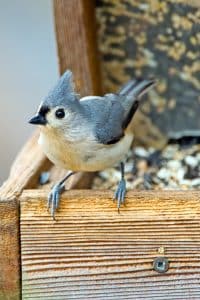Common Birds
Tufted Titmouse
The Tufted Titmouse is one of the most delightful birds that visits our feeders. It is the largest North American member of the Titmice family but is greatly outnumbered by the much smaller Black-capped Chickadee. This little gray bird with a white belly has large black eyes, a rounded bill with a small black patch above it, and a tufted crest giving them the name Tufted Titmouse. As with Chickadees, a member of the Titmouse family, they flit and flutter from branch to branch, hanging upside down, and then diving to the feeder to collect a seed. These two birds act nearly alike in their eating habits. They will take a seed at the feeder then usually retreat to a small branch to remove the hull from the seed then tear off small pieces and swallow them. Titmice seem to prefer peanuts over black oil sunflower seed and safflower seed, but any of the nut type seeds will keep them coming back for more.
This little gray bird with a white belly has large black eyes, a rounded bill with a small black patch above it, and a tufted crest giving them the name Tufted Titmouse. As with Chickadees, a member of the Titmouse family, they flit and flutter from branch to branch, hanging upside down, and then diving to the feeder to collect a seed. These two birds act nearly alike in their eating habits. They will take a seed at the feeder then usually retreat to a small branch to remove the hull from the seed then tear off small pieces and swallow them. Titmice seem to prefer peanuts over black oil sunflower seed and safflower seed, but any of the nut type seeds will keep them coming back for more.
Tufted Titmice can be found throughout most of the Eastern US woodlands from deciduous to pine forests and they often visit backyard bird feeders. They prefer wooded areas and neighborhoods with mature habitat much as the Chickadees do. Many years ago the Tufted Titmouse was primarily a bird occurring in southern states. But over the past century they expanded their range becoming a permanent resident bird into Southern Minnesota, Central Wisconsin and the eastern regions of the Central Plaines. Eastern Nebraska has been on the very western edge of their range but they continue to expand west from the Missouri and Eastern Platte River valleys where they have become quite common. In recent years more Titmice are being reported in and around the Lincoln area and we may have had a pair nest at the Pioneers Park Nature Center just last summer.
In the winter a small family flock of Titmice will defend a feeding territory of up to 15 acres. They will fend off another winter feeding bands of Titmice, but none-the-less are usually accompanied by Downy Woodpeckers, Chickadees, nuthatches in the same feeding area. All these birds are cavity nesters and considered to be birds of the tree trunk zone.
In the spring these winter feeding groups of Titmice breakup establishing small territories of up to 5 acres per pair. It is then you will hear the familiar Peter, Peter, Peter song. It rings loud and clear as the male begins to stakeout his territory and renews his bond with his mate.
The female Tufted Titmouse will build a nest in an old woodpecker cavity, a rotted out knot hole, even using man made nest boxes. She will take several days to fashion her nest out of moss, fine bark, leaves, hair, and occasionally snake shedding’s. Over the years reports have surfaced of the female Titmouse plucking hair directly from woodchucks, squirrels, raccoons, even a human who may be resting close to her nest site. When the nest is completed she will lay an average clutch of 5 to 6 white to creamy white eggs spotted with chestnut-red, brown, purple, or lilac. When the clutch is complete she will incubate the eggs for about 12 to 14 days until they hatch. After a few days of brooding the young chicks both parents will take on the duty to feed them as they remain in the nest for another 14 to 16 days before fledging. They will continue to rely on their parents to feed them for another week or two.
Tufted Titmice primarily feed on insects in the summer, caterpillars, beetles, ants and wasps, as well as spiders and snails, but will readily visit backyard bird feeders year round. Other natural foods include seeds, nuts, and berries. They appear to always take the largest seed or nut they can find when foraging. In the fall and winter they often hoard shelled seeds in the cracks and crevices of bark.
Tufted Titmice are acrobatic fliers foraging among mature trees, hanging upside down as they investigate the bottom of branches, pinecones, and clusters of leaves. As with Chickadees, Tufted Titmice are very vocal around their territories and are quick to react to the warning calls of other birds.
The continued range expansion of these very active little birds may be related to various reasons; a warming climate, the succession of trees along river channels, and the growing number of people that maintain bird feeders providing a supplemental food resource throughout the year. So keep your eyes open for a small tufted little gray bird full of energy flittering around in your backyard snatching seeds from your feeders. You just may be lucky enough to see a Tufted Titmouse or two.
